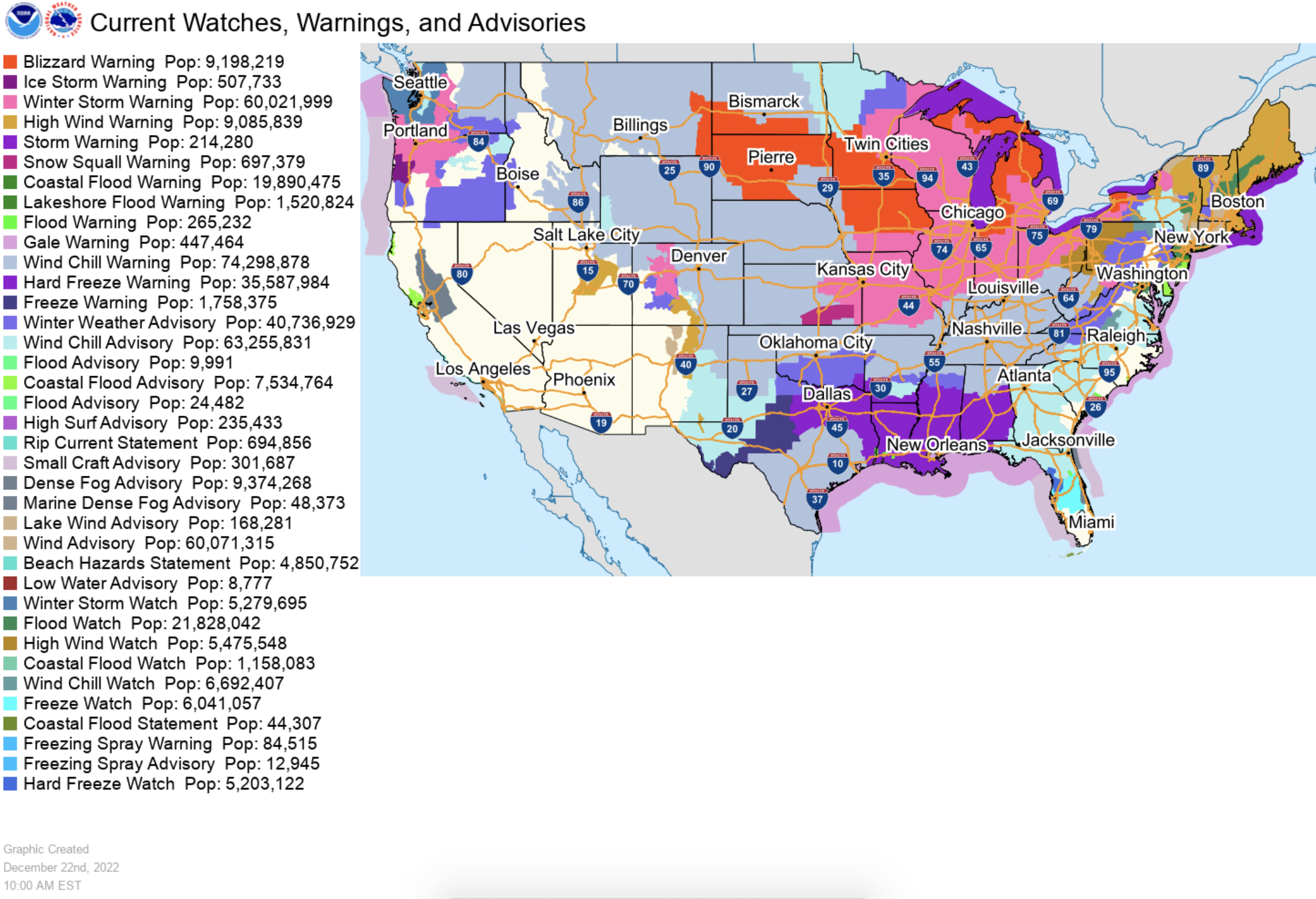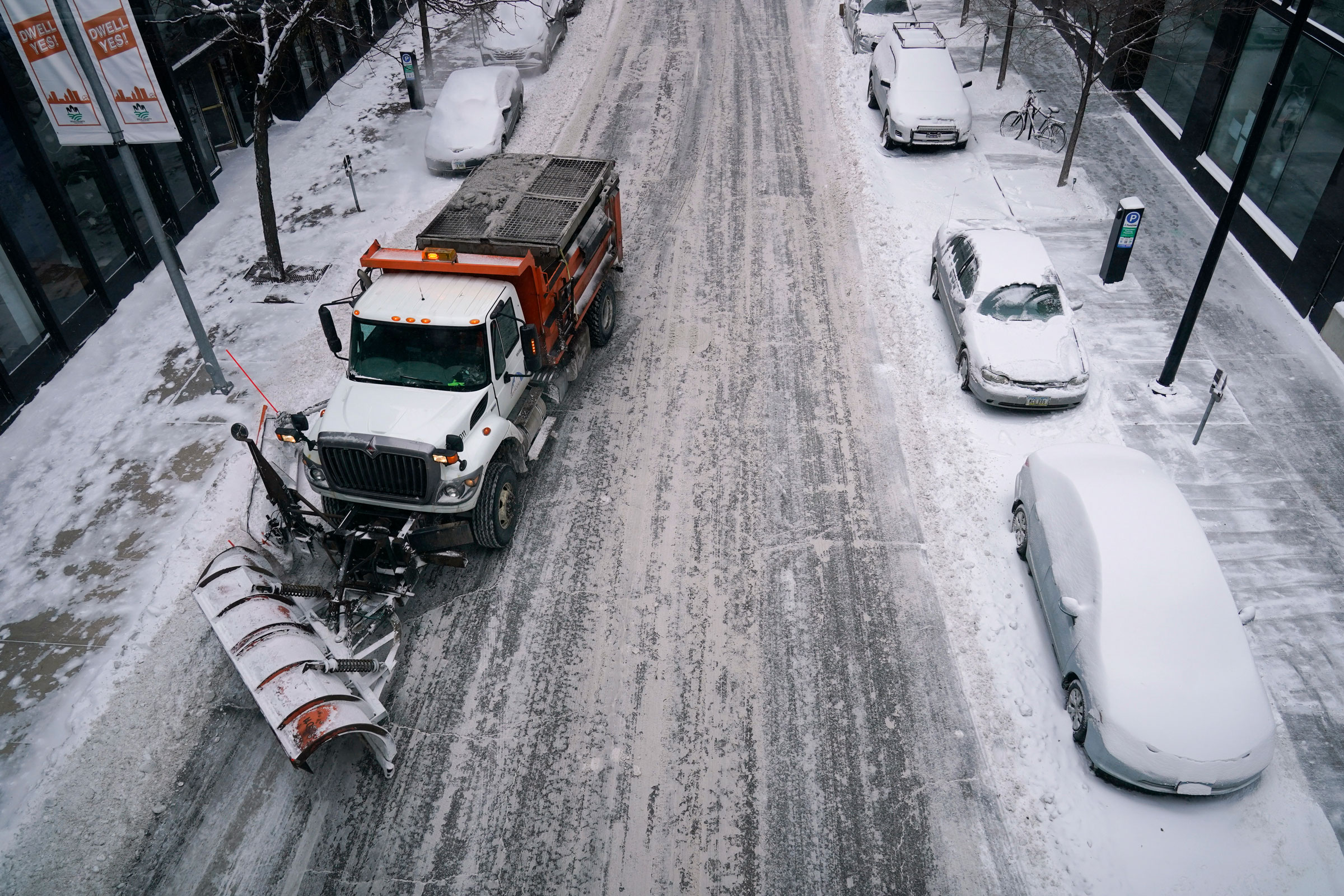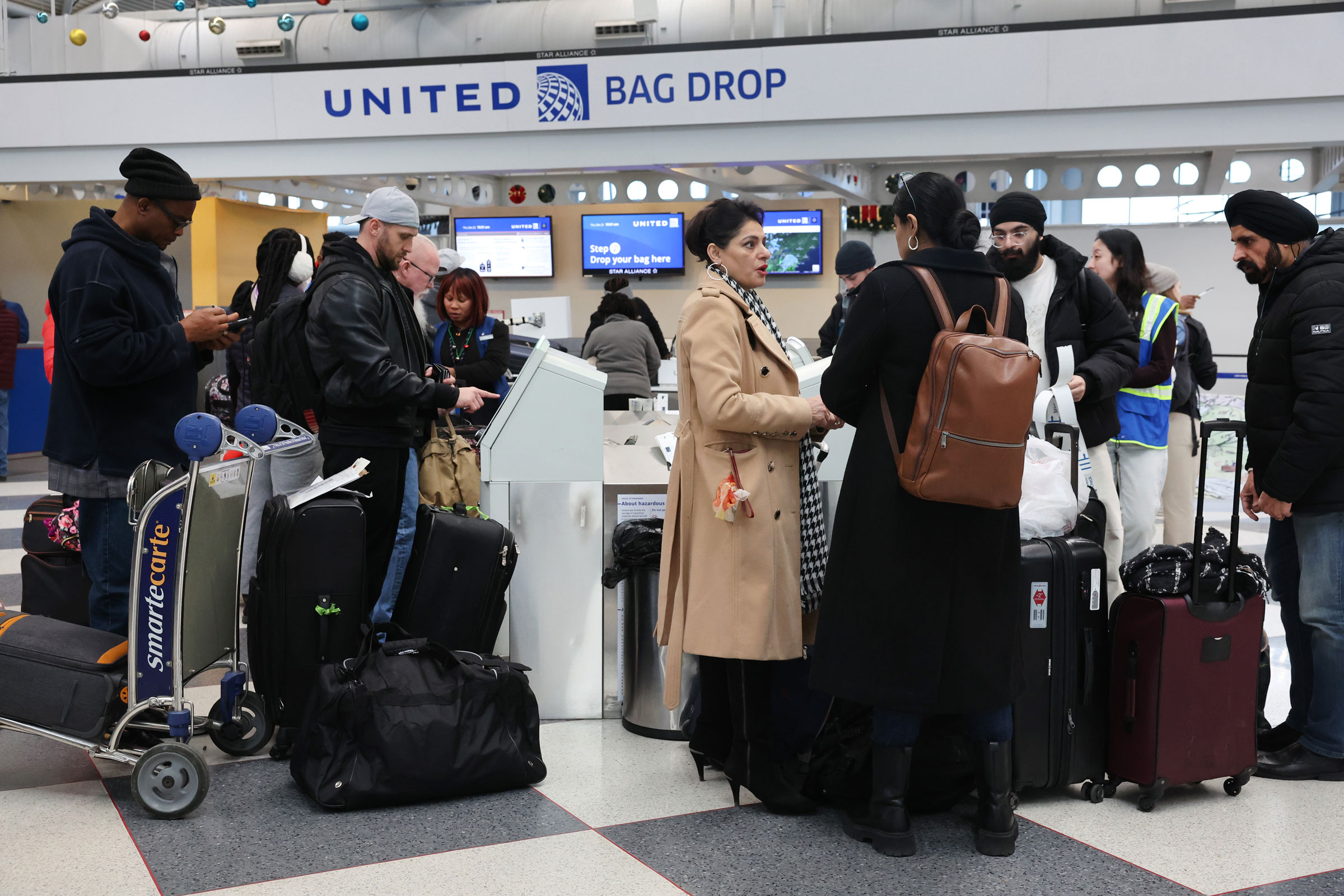A massive winter storm sweeping across the U.S. has caused at least 15 fatalities, left more than a million utility customers without power and impacted millions of Americans traveling for the holidays. Bitter cold temperatures are being recorded across the midwest, great plains and south. Airports in Chicago and Denver are seeing severe delays, and Seattle airport closed and reopened after a runway had to be de-iced. As of Saturday morning, more than 1,700 flights were canceled nationally.
The storm has officially reached bomb-cyclone criteria— a meteorological term that means that the pressure of a cyclone dropped 24 millibars (a unit of pressure) within 24 hours— and over 183 million people nationwide are under wind chill advisories and warnings. President Biden met with the National Weather Service and FEMA officials and is encouraging Americans to “take this storm extremely seriously.”

“This is not like a snow day when you were a kid,” Biden said Thursday morning in the Oval Office. “This is serious stuff.”
Minnesota meteorologist Sven Sundgaard advises locals to continue checking the latest weather forecasts ahead of travel plans. “It’s one thing to travel during a snowstorm that’s already treacherous, but then you add in these extreme wind chills and cold air and it can really become a dangerous situation,” he says.
Here’s what to know:
More from TIME
Who’s affected?
At least 15 deaths across the U.S. have been attributed to extreme weather conditions over the past few days. The majority of the fatalities came from vehicular accidents on dangerous roads, including two in Kentucky, according to Gov. Andy Beshear, four in Ohio, according to Gov. Mike DeWine, one in Wisconsin, according to the state patrol, three in Kansas, according to state highway patrol and one in Missouri, according to Kansas City police. Other storm victims included people with medical emergencies who couldn’t be reached by medical personnel in time, due to the storm.
“Stay off the roads. The last-second shopping is not worth it if it would cost you your life,” Beshear said at a briefing on Friday after reporting two deaths from car accidents and the death of an unhoused person.
By Saturday, power outages swept the nation, hitting North Carolina the hardest with more than 477,000 households, businesses and other electricity customers left in the dark.
Power outages prevalent in the Eastern U.S. are accompanied by high winds that threaten to knock over powerlines, trees and other structures. The weight of snow and the acute cold also work to stiffen power lines and technicians have trouble reaching their destinations for repairs. Tennessee, Maine, South Carolina and New York each have more than 70,000 customer outages too, and electrical grids in the Northeast are suffering the most, according to power outage.us.
Weather officials assured Texans that although this year’s storm will bring freezing temperatures to cities like Houston and Austin, it won’t be as long or snowy as the weeklong storm in Feb. 2021 that resulted in massive power grid failure.
“When it gets really cold down there, they have problems with the electrical grid, and people trying to heat their homes, demanding more and more electricity,” John Grushiak, a senior meteorologist at Accuweather, tells TIME. The Electric Reliability Council of Texas has said that it has upgraded since the last storm and “expects sufficient generation to meet forecasted demand.”
So far, Oklahoma has declared a state of emergency under hazardous road conditions, Louisiana’s governor is asking residents to prepare for life-threatening temperatures, Arkansas is anticipating flash-freezing today and Pierre Regional Airport in South Dakota’s capital has closed due to the weather. On Friday, more than 2,900 flights were delayed in the U.S. and over 3,600 were canceled, according to FlightAware.
The storm began moving through the Northwest on Monday night, bringing snow to Washington, more than a foot in the Olympic and Cascade Mountain regions. By Thursday morning, the storm hit the Northern Central and Midwestern parts of the country, where frigid temperatures remain well below freezing, like less than negative 15 degrees Fahrenheit in parts of Montana and Wyoming. With strong winds, it will feel closer to negative 30 or even 40 degrees Fahrenheit.
Blizzard-like conditions hit with about 6 inches of snowfall as the storm moved towards the Great Lakes late Thursday. Snow and sleet piled up on highways, so officials have advised against driving as accidents are being reported all over the country.
Some municipalities in New York and New Jersey have banned driving, or at least nonessential and commercial driving. Public transportation is also suffering from inclement weather and operations have halted or faced delays nationwide. Package deliveries are also facing widespread delays, especially impacting last-minute holiday shopping.

Parts of the East coast could experience record-low colds and will likely get some freezing rain. “When you get to the Southeast along the East coast, at least initially, it’s gonna get pretty warm. There’s going to be some rain, gusty winds and maybe even some thunderstorms, but by the time we get to Friday night, it’s going to get real cold,” Grushiak says.
New York Attorney General Letitia James warned people on Friday that they should be on the lookout for “fraudsters who may use this winter storm to take advantage of consumers” and criticized price gouging. “Charging excessive prices for essential products during emergencies is wrong, and it is illegal.”
Some communities, including Portland, Oregon, Buffalo, New York and Cincinnati, Ohio, have opened up warming centers—short-term, emergency shelters for unhoused people to spend the storm in.
“One of the big things about the storm and following it is going to be the cold,” Grushiak says. “It’s going to be one of the coldest Christmases that has ever occurred in a lot of places.”
As of Saturday , the National Weather Service had weather advisories and storm watches in effect in every state except New Mexico, Utah and Arizona.
Travel amid the storm

Weather conditions of this magnitude will require adjusting travel plans as necessary. Jalyn Souchek, a PR manager for Memphis Tourism, was expecting to drive eight hours north on Thursday to Cedar Rapids, Iowa to see her family, but she made arrangements with her job to leave a day early to ensure her safety.
Kareem George, a travel advisor for Culture Traveler, tells TIME that safety comes first while traveling through such conditions, but there are a few ways travelers can prepare for the inevitable delays.
“We always advise our travelers to purchase travel insurance. Depending on the travel insurance policy that a client may have, there are provisions for delays where funds can be allocated to cover additional costs for penalties or for hotels or various different costs that are associated with having to reschedule,” George says.
He explains that travel insurance can make the ordeal a lot easier, at least in terms of being reimbursed. George emphasizes the need to save your receipts and document delays, which is useful even for those without travel insurance, in case transportation companies offer refunds. Many major airlines—including United Airlines, Southwest Airlines, American Airlines, Jetblue and Spirit Airlines—have already begun issuing waivers that allow travelers to change their itineraries ahead of the storm.
Travel blogger Andrea Litwa, who lives in Carmel, Indiana, advises flexibility for a safer travel experience, even if it means changing or canceling your flight or driving arrangements for after the holidays, into January. “It’s so stressful when things don’t go as planned, but if you can get ahead of it, set your expectations, and know that you may have to pivot, that will help,” she says.
Nearly three million people are expected to travel for the holidays through Chicago, a busy airport hub. “In a major city like Chicago, there are several hotels that are within shuttle ride [distance],” George says. He suggests researching accommodation options beforehand or staying in touch with friends and family nearby in case you have a lengthy delay.
“Traveling carry-on only is something I often recommend whenever that’s possible,” George says. “You can have all of your appropriate items with you, whether that be medications or just toiletries and clothes, so you can be as comfortable as possible if you’re going to have to stay longer than anticipated in the airport.”
More Must-Reads from TIME
- Cybersecurity Experts Are Sounding the Alarm on DOGE
- Meet the 2025 Women of the Year
- The Harsh Truth About Disability Inclusion
- Why Do More Young Adults Have Cancer?
- Colman Domingo Leads With Radical Love
- How to Get Better at Doing Things Alone
- Michelle Zauner Stares Down the Darkness
Write to Mariah Espada at mariah.espada@time.com